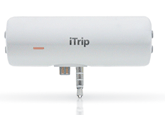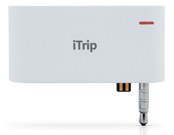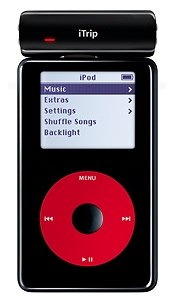|
|
|||||||
iPod Accessory Reviews: Griffin iTrip and iTrip miniEditor's rating (1-5): Review posted Dec. 15, 2005 by Jacob Spindel Do you enjoy listening to morning-show pranks and a selection of music geared toward a wide audience? Me neither! So why not play your iPod over your car's stereo system instead of boring old radio? Although not many cars have special built-in iPod Docks, almost all cars have a radio, so it's no surprise that short-range FM transmitters are available from numerous companies. Griffin Technology is one of the most popular vendors in the iPod accessory market, so I hoped that their iTrip line of FM transmitters would also be superior to the competition. I was not disappointed.
iSnap! I tried both the iTrip for 3G/4G iPod, and the iTrip for the iPod mini. Both models work by snapping into both the headphone jack and the remote port on top of these models. The only real difference between the two is that the iTrip mini is smaller and designed to fit more comfortably on an iPod mini. Because the configuration of their headphone and remote ports is identical, you can actually use the iTrip for 3G/4G iPod with the iPod mini as well, if you don't mind it hanging off the right edge. Both models have a single red light that indicates the unit's status, and have no additional controls or displays. They broadcast an FM radio signal with a range of about 10-30 feet, which allows you to listen to your iPod's output on any standard radio, including car radios. Both iTrip models carry Apple's official "Made for iPod" logo.
Griffin not only designs their iTrips with specific iPod models in mind, but they also design them with the user in mind. Some companies ask, "What would be cool to build with the technology we have?" However, it is clear from the elegant design of their products that Griffin asks, "What would I actually want to use?" The designer of the product knows you don't want to bother with a bunch of unruly cables - that's why both iTrip models just snap directly onto your iPod to make an attractive combination that can be transported as easily as the iPod alone. They know that dealing with extra batteries is a huge hassle and increases a product's long-term cost - that's why the iTrip is powered entirely by the iPod. And Griffin also knows that figuring out when to turn the device on or off can easily become overcomplicated, which is why the iTrip turns itself on and off completely automatically, based on the current iPod state. The U2 Editional iPod owners rejoice! iSnap! also comes in a special black version of the 3G/4G model in addition to the regular white, to match your U2 iPod. (However, the mini version only comes in white, even though there are multiple mini colors.) |
Advertisement |
|
The only disadvantage with this design is that you can't use a remote control or any other products that connect to the headphone or remote ports while using the iTrip. I don't see this as a major problem, though, since wired remotes are rarely used anyway (newer iPods aren't even compatible with them), and few users ever need to broadcast an FM signal and use headphones simultaneously. My brief testing indicates that, as far as I can tell, the iTrip does not interfere with the use of peripherals that connect to the Dock Connector port. Also, note that they will not work with other iPod models, or anything other than an iPod. I think this is reasonable considering how carefully tailored it is to the iPods' own design. iSlick Both iTrip models are a joy to use. It's very simple - just snap it to the top of your iPod, and you will start broadcasting an FM signal whenever your iPod plays music. You may have to perform a brief configuration process the first time you use the iTrip, but this is explained well in both the software and the instructions, and most users will only need to do it once. I found that if I stayed within about 10 feet of any of the radios I tried (with either iTrip model), quality was comparable to regular FM radio. I quickly realized that setting the iPod volume higher than about 80% causes major distortion on the radio, but this is explicitly mentioned on Griffin's own site, and it is simple enough to keep the volume at about 75-80% and use the radio's volume control to adjust the actual loudness. Newer models for newer iPods automatically modulate the iPod's sound volume, but I have not had a chance to test this feature personally. It was always easy to find a place to sit or stand that produced optimum audio quality. Although I didn't get perfect results from every location in a given room or car, it never took long to find a comfortable place that produced clear audio with no static. So unless you need to be in constant motion or have absolutely no ability to move both your radio and your iPod for some reason, you should be able to achieve just about the best quality you could expect from FM radio, easily. In fact, in some spots, the signal was so strong and clear that, even if I intentionally set it to a frequency that conflicted with a local radio station, the iTrip actually overrode the station's frequency and still provided a clear signal to the radio that did not seem noticeably affected by the real station's signal. (I suppose you could use this to play a prank on a nearby person who is blasting a Walkman too loudly, if you know what station they are listening to. Not responsible for Walkmen shoved up your nose.) Since the iTrip gets its power directly from the iPod, many potential buyers are concerned about the battery drain on the iPod itself. However, there is really nothing to be concerned about. I cannot see any difference in the battery drain rate between using the regular earbuds and using the iTrip. |
Advertisement |
|
iSlip-Up Setting the broadcast frequency for your iTrip is probably the weak point of both models. Since the iTrip and iTrip mini have no screens or buttons, Griffin includes on the CD a group of 102 small audio files, each representing a possible broadcast frequency that can be used in the United States. To set either iTrip model to use a given frequency, play the file corresponding to that frequency on your iPod and press Play/Pause when the iTrip's light begins to blink rapidly. (To a human, the files just sound like a few seconds of beeping.) If your Griffin CD should get lost (or buried under a stack of 12,000 AOL CDs), you can get these files back with an easy 1.1 MB download from www.griffintechnology.com/software/. You can also download other frequency sets for other countries, but at this writing, the most recent source I could find indicates that the iTrip and all similar devices are still illegal in the United Kingdom. Griffin's iTrip software is available for Mac OS 9, Mac OS X, and Windows 2000/XP.
This procedure is cleverly designed and
easy enough to follow when you have the instructions right in
front of you, but it also presents several potential problems.
If you need to change the frequency of your iTrip on a regular
basis, you will need to leave the sound files on your iPod at
all times. This can make quite a mess of your music library on
the iPod, and on iTunes as well, if you use automatic syncing.
You can prevent the files from coming up in "Shuffle" mode by selecting the files in iTunes
and choosing the "Skip when Shuffling" option under the
Options pane (this option is only available on iTunes 5 and later),
but if you use smart playlists to track things like most played
songs or newest tracks, you may have to alter the conditions of
the smart playlists if you don't want these audio files to appear
in them. If you're on the road and you have previously decided to delete
the frequency audio files, you are left with no way to change the
frequency. Moreover, even if you still have the frequency files,
the procedure for setting the frequency may be difficult to remember
without the instructions. Finally, I am not aware of any way to
check what the current frequency is, regardless of which files
you have installed, which means that even if you are content to
leave the iTrip on the same frequency at all times, you may be
in trouble if you forget which frequency you chose. Newer models for newer iPods have attempted to address this issue. I have not had a chance to test these models at press time, but I'm glad to see that Griffin is working on it - this reinforces my belief that they are actually paying attention to what real customers want. iConclusion I admire Griffin's attention to detail, and I am convinced that the iTrip products are the best FM transmitters for iPod. Pro: Con:
Web Site: www.griffintechnology.com Comparison Shopping: Where to Buy
|





